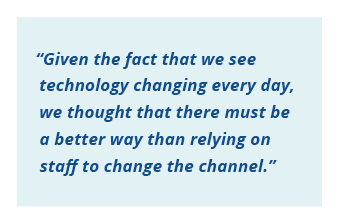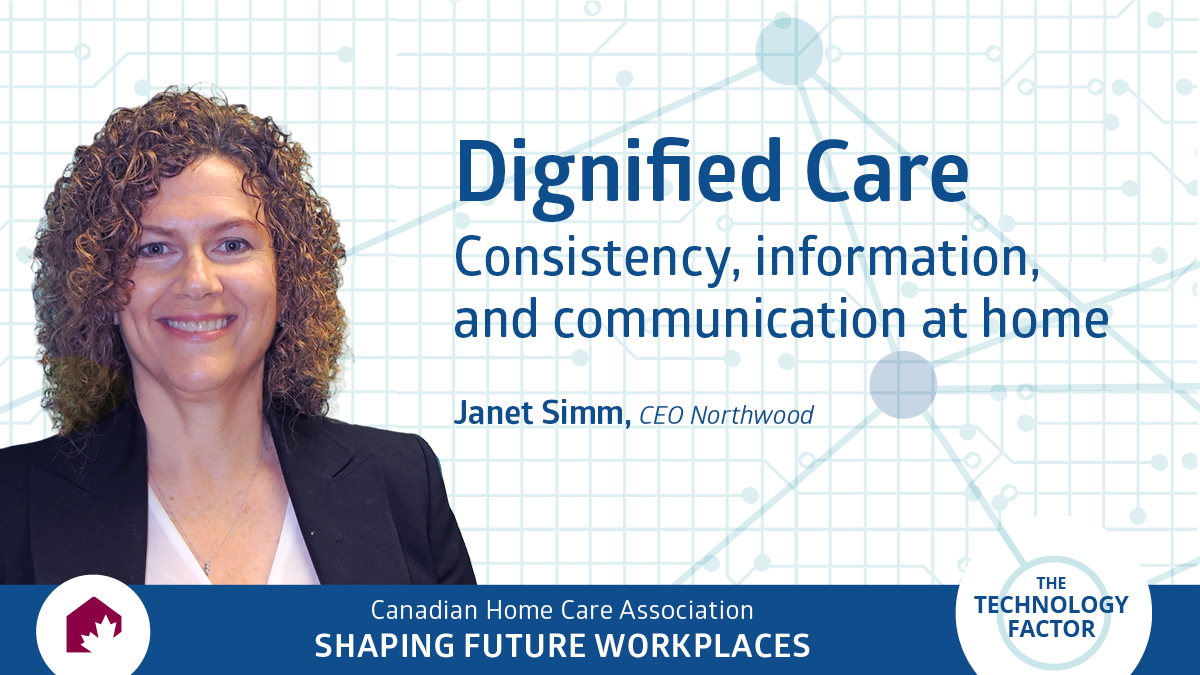Dignified Care
Consistency, information, and communication at home
Imagine having to rely on someone to come in to turn on or off lights, raise or lower the head of the bed, open or close a door, and even change the television channel. Staff understand this need and strive to be responsive. However, over the past few years, shortages have led to prioritizing direct care over “non-urgent” functional activities. Clients, aware of the demands on staff, have often been reluctant to ask for help because they are aware of the staff workload. The situation is demoralizing for clients and depressing for staff, as they feel frustrated that they cannot do more than the essential care for those they serve. Shortages of staff escalated frustration. We knew that a solution had to be found.
 We decided that we needed to use technology to better enable people to control their own environment. In partnership with Dalhousie University, and together with academic and commercial partners, we launched a transdisciplinary research initiative, Living More with SMART Technology (LivMoreSMARTech) which was funded by AGE WELL, Mitacs, and the Nova Scotia Department of Seniors and Long-Term Care Innovation Program. (i)
We decided that we needed to use technology to better enable people to control their own environment. In partnership with Dalhousie University, and together with academic and commercial partners, we launched a transdisciplinary research initiative, Living More with SMART Technology (LivMoreSMARTech) which was funded by AGE WELL, Mitacs, and the Nova Scotia Department of Seniors and Long-Term Care Innovation Program. (i)
Our goal is to look at the adoption of affordable SMART tech and its impact on quality of life and quality of work life as we work to better support client autonomy and independence. The project started in long term care, with a second phase examining the introduction of SMART tech into individuals’ homes in the community.
 We chose a unit where young adults (under the age of 65 years) with significant physical challenges live. Their needs include assistance with activities of daily living (ADLs) and many basic physical tasks such as turning a fan on or off. We worked with Novalte, a company that focuses on technology to support personal independence (ii). The device that we introduced translates voice commands to existing equipment without the need for costly to upgrades or customizations. The technology, emitto, seamlessly connects existing smart technologies, whether infrared, blue tooth, radio frequency or WIFI, into a single platform responsive to voice commands.
We chose a unit where young adults (under the age of 65 years) with significant physical challenges live. Their needs include assistance with activities of daily living (ADLs) and many basic physical tasks such as turning a fan on or off. We worked with Novalte, a company that focuses on technology to support personal independence (ii). The device that we introduced translates voice commands to existing equipment without the need for costly to upgrades or customizations. The technology, emitto, seamlessly connects existing smart technologies, whether infrared, blue tooth, radio frequency or WIFI, into a single platform responsive to voice commands.
While the evaluation has not been published as of yet, our observations have been positive. The ability of clients to control their environment has had a profound positive impact on their mood and their self-described quality of life. Their voice translates directly to action. Staff are delighted as well and have advocated for the solution to be implemented quickly and equitably across all residents and to those in need of support with functional activities in the community. Many of our clients in the community are literally waiting for the home care staff to arrive to start and/or end their day. With enabling technology, clients can potentially better control their environment and not be so dependent upon the time of day that our staff walks through the door.
In addition to testing emitto in home care, we are planning for a portal that supports contributions from clients, their families, and staff. This will position clients to see who is coming and at what time – even as schedules change over the course of the day due to unexpected interventions. Staff will be able to see client instructions before they arrive – perhaps where to park, or the door to use etc.
We are also starting a program of equipping home care staff with tablets so they can more easily see the care plan and instructions. The portal and the tablets will address our client feedback for: 1) consistency of care provider; 2) knowing when the staff are coming; and 3) not being required to repeatedly answer the same questions with each staff member. Getting the answers to important questions documented so staff have the answers before going into a home is about respect.
We believe that the best staff want to work with organizations that are working to increase client dignity and empowerment. Our philosophy is to bring off-the-shelf technology solutions, individually customized to maximize wellbeing. Notwithstanding the leveraging of ready-made solutions, we believe that long-term care and home care will need specific tech support for each setting. Responsiveness will be vital as we build a model of care that relies on technology as key component of the offering.
Ultimately a commitment to supportive technology needs to be policy-based, so technology can become equitably accessible. Technology will need to be part of the home care offering to positively impact the quality of life of individuals on the program.
References
[i] AGE-WELL. Core research Program Awards 2020 – 2023 (by Challenge Areas) Living More with SMART Technology: Exploring the feasibility, usability, sustainability, and scalability of SMART solutions to increase quality of life in Continuing Care. Retrieved from https://agewell-nce.ca/wp-content/uploads/2021/05/PDF-CRP-1.pdf
[ii] Novalte (website) https://novalte.ca/about-us.html





